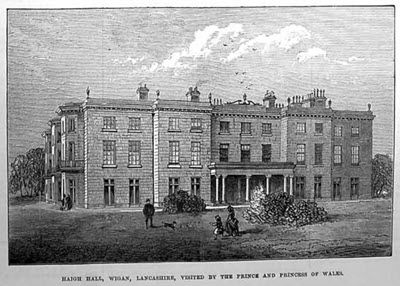1873 - The Royal Visit

In June 1873, King Edward VII and Queen Alexandra, then Prince and Princess of Wales, came to Wigan to open the Royal Albert Edward Infirmary, and stayed at Haigh Hall.
Imagine the Hall at that time, filled with beautiful things, pictures, antique furniture, china, books and manuscripts. The entire Hall was re-decorated, rc-carpeted and curtained for the visit, and the work was carried out by a London firm in a month, according to the designs and instructions of Lady Crawford, at a cost of £80,000.
The curtains were chiefly of Italian manufacture. The main staircase and corridors were covered with crimson and black Indian carpets. In the entrance hall were placed quaint and curious Spanish chairs upholstered in leather and gold. Exotic plants provided the floral decoration.
The morning room furniture was upholstered in velvet and silk. The long library, which is the large room on the ground floor overlooking the canal, became the banqueting hall. The sideboard was covered with gold plate. The dining chairs were crimson and green, except those used by the Royal personages, which were of silk and gold. Exotic plants again completed the decorations.
At the top of the grand staircase stood a maplewood cabinet with its Worcester tea service decorated in Oriental style, its Wedgwood dinner service, its Minton porcelain dessert service complete with ten candelabra, its green and gilt Sevres cups and saucers, and its Dresden painted and gilt cups.
Three rooms on the first-floor enjoy the view across the estate to Wigan : an ante-room, the drawing-room, and the boudoir. The boudoir was specially decorated for the Princess in white and gold. The floor was covered with Persian carpets, the amber curtains were of Italian silk, the furniture was upholstered in velvet, while an ebony grand piano completed the arrangements for the Princess's private comfort.
The drawing-room was, perhaps, the masterpiece of this artistic interior decoration, with its Persian and Turkey carpets, curtains specially woven from France, its grand piano, elegant chairs, marqueterie tables and cabinets, graced with at least 30 vases of flowers, and 80 paintings by Old Masters, including Botticelli, van Dyck, and Sir Joshua Reynolds.
The Royal bedstead was of walnut marquetcrie, exquisitely carved, and said to have been a present to the Earl from a member of the Italian Royal Family. The curtains and coverlet were of crimson silk trimmed with white, while the wardrobe was of satinwood inlaid with tulipwood of particularly fine workmanship.
The drive was decorated with banners specially sent from Florence, erected on poles 20 yards high, and 24 yards apart, which could be seen from the entire stretch of the road between the two lodges in Wigan Lane.
The complete stretch of the two mile drive through the plantations looked like a floral arcade. There was a triumphal arch decorated with evergreens and banners at the canal bridge, and another at the terrace 35 feetin height of Gothic design, constructed of rhododendron leaves, spruce and fir, surmounted on either side by a Prince of Wales plume.
2,000 schoolchildren lined the route near the terrace. Unfortunately the weather was not good, and just as the porch was reached the threatened thunderstorm broke and sent the spectators scurrying for shelter.
The 30 stalls in the stables were occupied, and 12 horses had to be accommodated elsewhere. 150 servants and 50 members of the Lancashire County Constabulary slept in out-buildings and specially erected tents.
The Royal apartments were thrown open to the public for three days after the Royal visitors had left, upon payment of 6d., and the proceeds were given to the Infirmary funds.
Extract from a booklet of the history of Haigh Hall produced in 1957 by H.H.G. Arthur, Wigan Council Librarian. An excellent overview.
Image provided by Ron Hunt